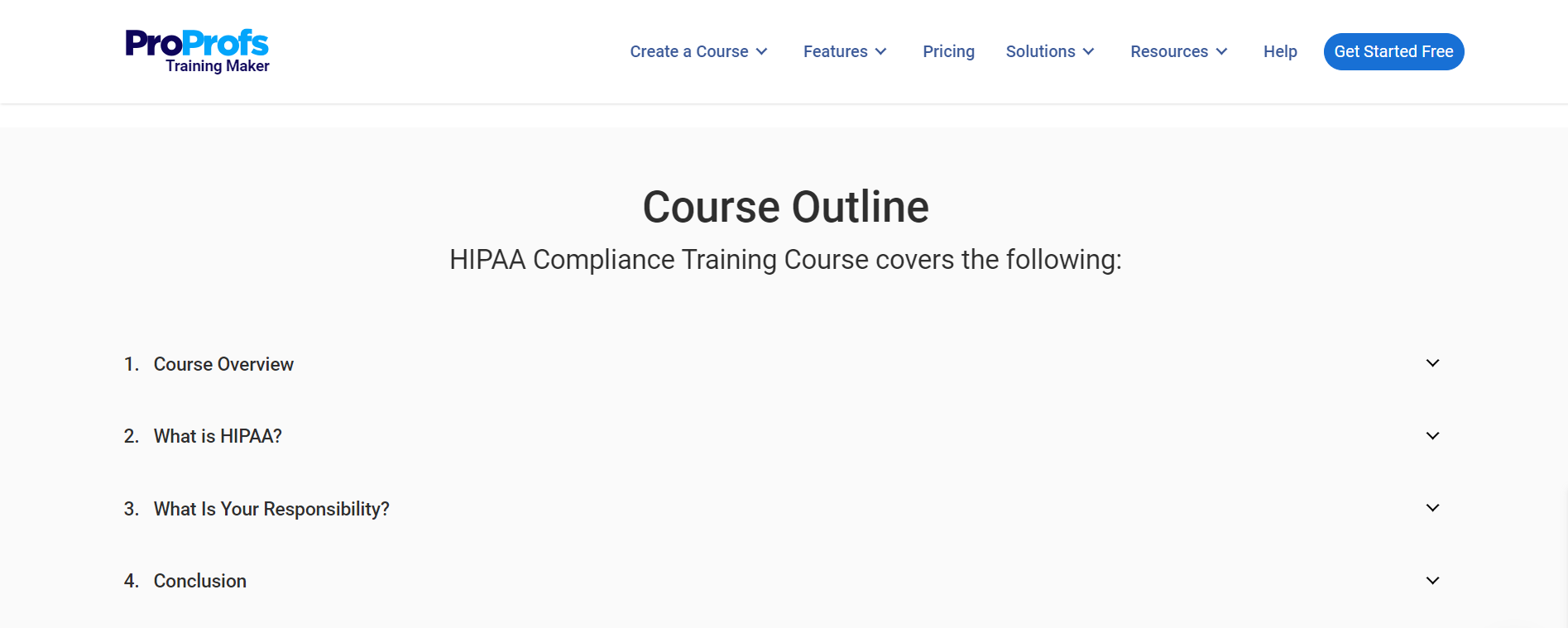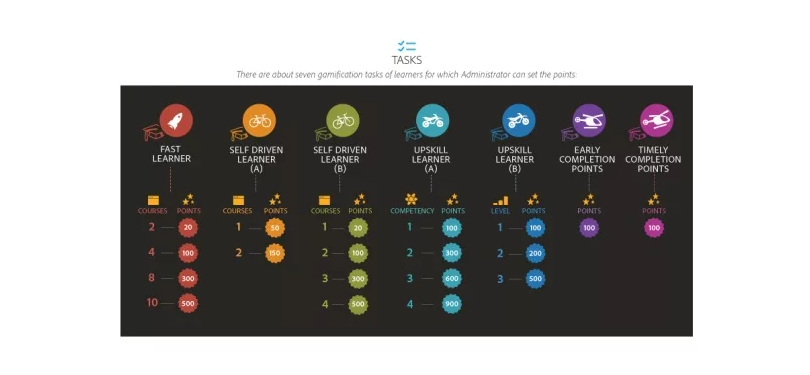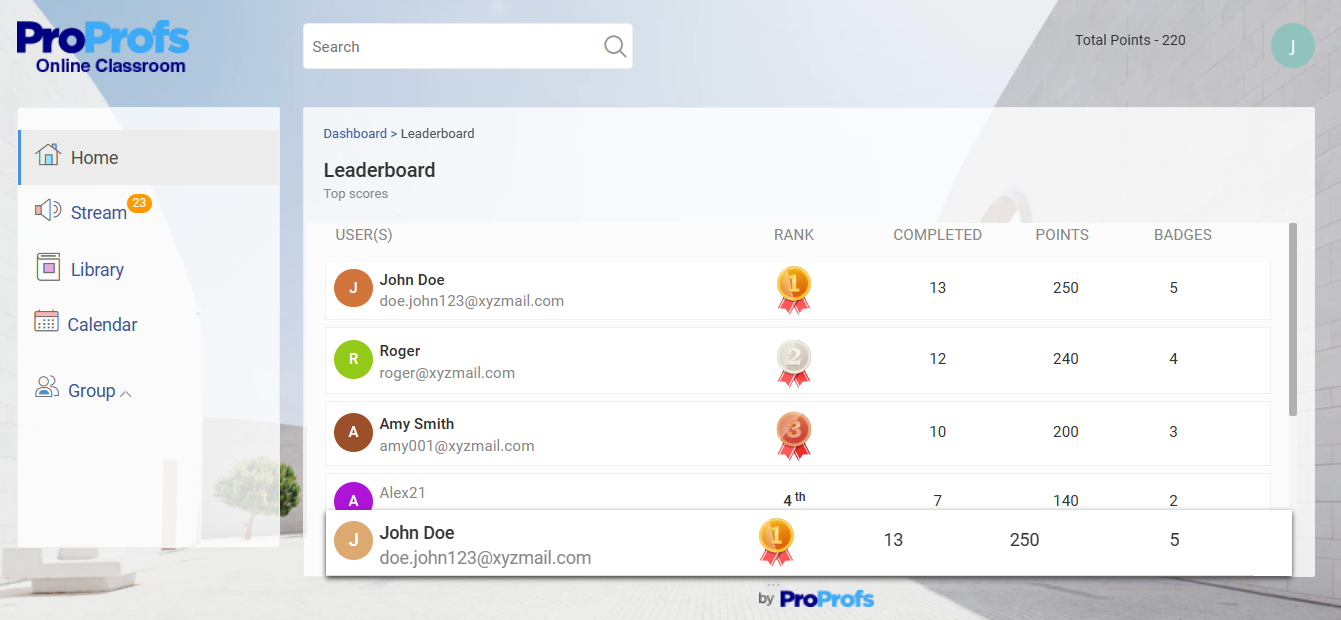Are you tired of the traditional, bland ways of learning that leave your learners feeling uninspired and unmotivated?
I understand the pain of trying to grasp complex concepts without any engagement or enjoyment.
Here, eLearning gamification is a silver lining – a powerful strategy that adds a thrilling twist to the learning process.
Let’s look at the importance and examples of gamification in eLearning, along with how to implement it and what the future promises.
What Is Gamification in eLearning?
“Gamification is 75% psychology and 25% technology.” – Gabe Zichermann, gamification expert
Gamification in online learning refers to the process of incorporating game elements and mechanics into educational experiences. It involves using concepts from video games, such as challenges, points, badges, and leaderboards, to enhance learner motivation and engagement.
The goal of gamification is to make the learning experience more enjoyable and inspire learners to continue their educational journey.
This method of learning instills a sense of competition among participants to emerge victorious vis-à-vis their stated learning goals. It ensures a higher course completion rate and shorter time to productivity.
It also enables you to incentivize learning, increase the learnability quotient, and make learning stick.
Importance of eLearning Gamification
As an innovative approach to learning, gamification is significant for several reasons. Here’s a quick overview of the importance of gamification in eLearning.
- Heightened Engagement: Gamification introduces elements of challenges, rewards, and excitement into online learning. This naturally makes learning more interactive and engaging. By tapping into the natural human desire for competition and achievement, learners are more likely to remain focused and participate actively in their educational journey.
- Increased Motivation: The reward system inherent in gamification motivates learners to progress through the material. Achieving goals and earning rewards provides positive reinforcement that encourages continued participation and effort. This motivation can lead to improved completion rates for eLearning courses.
- Personalized Learning Experiences: Gamification supports personalized learning paths where learners can choose challenges that match their individual learning pace and interests. This personalization ensures that the learning experience is relevant and effective for each learner besides accommodating different styles and speeds of learning.
- Enhanced Knowledge Retention: The engaging and interactive nature of gamified learning helps improve knowledge retention and recall. By applying concepts in a game-based context, learners can better understand and remember information, as the process often involves problem-solving and critical thinking.
- Immediate Feedback: Gamification provides immediate feedback on learners’ performance, which is crucial for the learning process. This feedback enables learners to understand their mistakes and correct them in real-time to gain a deeper understanding of the subject matter.
In summary, the importance of eLearning gamification lies in its ability to make learning more engaging, personalized, and effective. By incorporating game elements into educational content, learners can enjoy a more motivating and memorable learning experience, which ultimately leads to better outcomes.
Case Study
How Language Connections saw an immediate increase in learner enrollment with engaging online training.
7 eLearning Gamification Examples
Gamification in eLearning comes in several forms. Some of the common ones include:
- Badges: These are digital rewards that learners can earn for completing tasks, passing quizzes or tests, or reaching certain milestones in a course.

- Leaderboards: Leaderboards rank learners based on their performance and can be used to encourage friendly competition and motivate learners to complete more activities in order to move up the board.

- Storytelling: Gamifying a course through storytelling creates an immersive experience for learners by connecting the content to a narrative or scenario that engages them emotionally.
- Branching Scenarios: Branching scenarios are interactive simulations where learners make choices that affect the outcome of the scenario. They are a popular way to gamify eLearning by creating a more engaging and memorable experience.
- Gamified Assessments: They add a layer of challenge or competition to assessments by allowing learners to answer questions, earn points, and unlock rewards as they progress.

- Quizzes: Turning quizzes into a gamified experience can make the learning process more engaging and enjoyable. Incorporating features such as time limits, countdowns, levels, and rewards for correct answers can motivate learners to participate and strive for better scores actively.
- Progress Tracking: Progress tracking involves visualizing learners’ advancement through courses or skills, often via progress bars, levels, or badges. This technique motivates learners by providing tangible evidence of their achievements and remaining challenges, fostering a sense of accomplishment and encouraging continuous engagement in the learning process.

These are the top examples of eLearning gamification. The possibilities are virtually endless and which one you deploy depends on your learning objectives and the audience.
Strategies for Implementing Gamification in eLearning
“In every job that must be done, there is an element of fun. You find the fun, and – snap! The job’s a game!” – Mary Poppins by P.L. Travers
Here are some of the essential strategies to consider when administering gamified learning:
- Define Clear Learning Objectives & Game Goals: Align the gamification elements you have in mind with the learning objectives of your course. Ensure that each game mechanic directly contributes to achieving specific learning outcomes.
Always start with your eLearning goals in mind before selecting gamification elements. This will ensure that the game mechanics serve the learning content, not the other way around.
- Incorporate Points, Badges & Leaderboards: Use points as a measure of achievement, badges to signify accomplishments, and leaderboards to foster competition. This approach motivates learners to engage more deeply with the content.
Point to remember:✨ Ensure that the rewards are meaningful and aligned with the learners’ motivations. Overemphasis on competition can demotivate those at the bottom of the leaderboard. Balance is key.
- Utilize Storytelling & Scenarios: Embed learning materials within stories or real-life scenarios to make the content more relatable and engaging. This can help in contextualizing the learning material and making it easier to understand and retain.
Use narratives that resonate with your audience’s experiences or aspirations to increase engagement and emotional investment in the learning process.
- Offer Immediate Feedback: Provide instant feedback on learners’ actions to guide them toward the correct understanding and to encourage persistence. Immediate feedback helps learners understand their mistakes and learn from them on the spot.

Remember: Feedback should be constructive and supportive. It should focus on the effort and strategies rather than the innate ability to encourage a growth mindset.
- Create Levels or Stages: Design your eLearning course with levels or stages that learners can progress through. This can help structure the learning experience and provide a clear sense of progression and achievement.

Ensure that each level builds on the previous one in terms of difficulty and complexity. This will allow learners to build their knowledge and skills gradually.
- Incorporate Social Elements: Let your learners collaborate, compete, or share achievements with their peers. Social interactions can enhance the learning experience, provide support, and foster a sense of community.
Privacy and consent are paramount. Make sure you create a safe and inclusive environment where learners feel comfortable sharing and interacting. - Enable Personalization & Choice: Give learners the ability to customize their learning paths or choose how to approach tasks. Personalization can increase engagement by catering to individual learning styles and preferences.
Offer various types of content and activities to cater to different learning preferences (visual, auditory, kinesthetic, etc.), but keep the overall learning goals in sight to ensure coherence and focus.
- Utilize Challenge & Curiosity: Design challenges that are neither too easy nor too hard, and use elements of surprise or curiosity to keep learners engaged. Appropriate challenges motivate learners to push their boundaries and engage more deeply with the content.
Remember: The key is to find the sweet spot in difficulty level that keeps learners in a state of flow, where they are fully immersed and motivated by the challenge at hand.
Remember, the goal of gamification is not just to make learning fun, but to enhance the educational experience in a way that motivates learners, makes the content more accessible, and improves retention and application of knowledge.
Always keep the focus on learning outcomes and consider the unique needs and preferences of your audience when implementing these strategies.
Get Free eLearning Authoring Software — All Features, Forever.
We've helped 567 companies train 200,000+ employees. Create courses in under a minute with our AI LMS or use 200+ ready-made courses on compliance, harassment, DEI, onboarding, and more!
6 Best eLearning Gamification Platforms
The following are the top six gamified learning platforms you can use to put your eLearning gamification ideas into action:
1. ProProfs Training Maker
ProProfs Training Maker is a top-rated eLearning gamification platform for creating courses with gamified elements. The platform offers interactive features for quizzes, assessments, surveys, and flashcards.
With its intuitive interface and drag-and-drop builder, you can easily create gamified and engaging training content. Besides driving more engagement in learners, the badges, points, leaderboards, quizzes, and more in the platform can help boost online training completion, retention, and performance.

The gamification learning management system (LMS) is notable for its variety of gamification options and an extensive library of pre-built courses and templates. It is suitable for new hire onboarding, skills training, eLearning, and compliance.
2. Adobe Captivate Prime

Adobe Captivate Prime incorporates gamification to boost learner engagement and inspire them to reach their objectives through game-like strategies.
This approach also enhances the rate at which courses are completed. It allows learners to engage in friendly competition with their peers, earning points for different educational tasks and ascending through levels from bronze to platinum.
Tasks can be turned on or off by administrators, who also have the ability to adjust how points are distributed for each task.
Initially, sample points and data for gamification are provided to help users grasp the concept, which they can then customize according to their needs.
3. MindTickle

MindTickle is a sales readiness platform that combines eLearning with gamification to enhance sales force performance. It utilizes game elements such as leaderboards, missions, and challenges to motivate sales teams.
The platform’s unique selling point lies in its sales-specific gamification features that help improve product knowledge, sales skills, and overall performance.
By leveraging gamification to engage its users, MindTickle makes learning and training more interactive and enjoyable.
This approach helps in reinforcing learning, improving performance, and driving sales productivity by making the learning process more engaging and rewarding for employees.
4. Kahoot!

Kahoot! is a game-based eLearning platform that brings engagement and fun to schools, workplaces, and homes. Users can create and take customizable quizzes and surveys, and engage in discussions.
It can be used both in the classroom and for remote learning, as it includes features like real-time tracking, competition, and teamwork.
Kahoot! provides a vast library of ready-to-play games and a collaborative and engaging learning environment.
5. Classcraft

Classcraft is a gamified learning management system designed to make learning more enjoyable and interactive for participants. It gamifies the classroom experience by incorporating elements of storytelling, teamwork, and role-playing.
A unique feature of the platform is its ability to transform the classroom into an immersive role-playing game (RPG)-style adventure, where learners earn points, level up, and tackle challenges together.
Participants can choose roles, such as mage, warrior, or healer, that come with specific powers and responsibilities. These roles are designed to promote teamwork, as learners must work together to succeed. Each role has unique abilities that can help the team or individual learners to achieve their goals.
6. 360Learning

360Learning is a collaborative learning platform that integrates gamification to promote engagement and knowledge retention. Its gamification tactics are inspired by widely used web practices. These strategies focus on human interaction as the core of training.
In addition, 360Learning is designed to be mobile-friendly and learners can engage with the platform and its gamification features on various devices.
360Learning’s distinctive feature is its focus on peer-to-peer learning where users can share and discuss content.
These platforms are highly regarded in the eLearning industry due to their effective use of gamification. They are great at enhancing learner engagement, motivation, and knowledge retention. Each platform offers unique features and functionalities that cater to different learning needs and preferences.
The Future of Gamification in eLearning
The global education gamification market was worth $697.26 million in 2020 and is projected to reach $4,144.97 million by 2027, at a CAGR of 29.00% during the forecast period 2021-2027.
According to eLearning Industry, online learning is likely to continue incorporating gamification as a way to improve engagement and retention of information. The potential to enrich gamified learning through the introduction of new technologies such as AI, big data, cloud technology, IoT, mobile learning, and VR is encouraging the industry to explore diverse game-based learning methods.
That’s why the future of gamification in eLearning is poised to be increasingly significant and transformative.
Some of the key trends and projections that are expected to shape the future of gamification in eLearning are:
- increased personalization
- immersive learning environments
- social learning
- microlearning
- data-driven insights
“The future of education is games-based learning. Games have the power to engage and motivate learners in ways that traditional methods cannot.” – James Paul Gee, American researcher
In the corporate world, gamification will be increasingly adopted for training and development. It will be used for a wide range of applications, from onboarding new employees to developing specific skills and competencies.
Also, future gamification efforts will focus more on accessibility and inclusivity to ensure that eLearning platforms are usable for people with disabilities. This includes designing games that are accessible to learners with visual, auditory, motor, or cognitive impairments.
While much of the focus has been on K-12 and higher education, gamification is set to expand into non-traditional education sectors, including lifelong learning, informal learning, and professional development.
As gamification becomes more prevalent, there will be a greater emphasis on ethical considerations. People will ensure that game elements do not lead to addiction or negatively impact mental health. Responsible design principles will prioritize the well-being of learners while achieving educational goals.
Start Gamifying Your eLearning Initiatives!
By harnessing the transformative power of gamification, online learning can become more enjoyable, impactful, and rewarding.
Deploy the eLearning gamification platforms and the proven strategies to see gamified learning in action.
Remember, elearning gamification is not a fad but a big shift in how learners acquire knowledge and skills online.
The only key to unlocking this potential lies in your willingness to experiment, adapt, and innovate. So, take bold steps forward and make learning a memorable experience for everyone.






 We'd love your feedback!
We'd love your feedback! Thanks for your feedback!
Thanks for your feedback!








